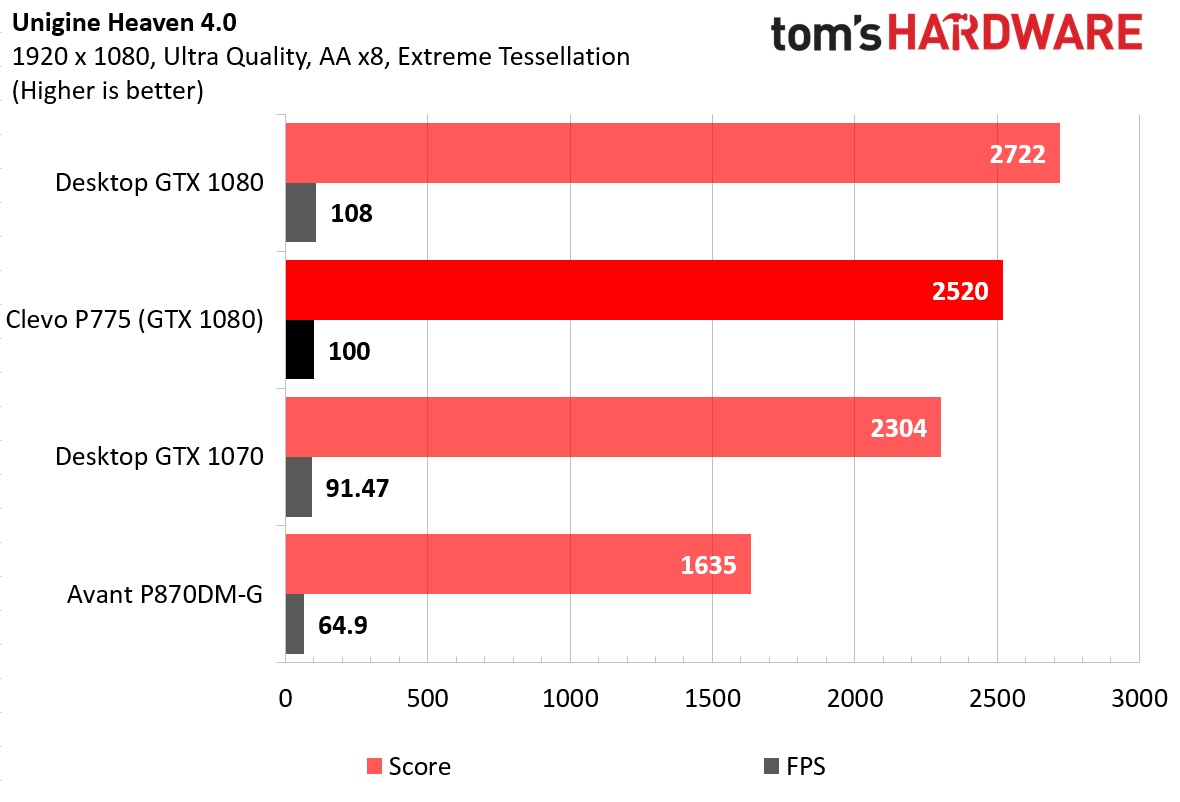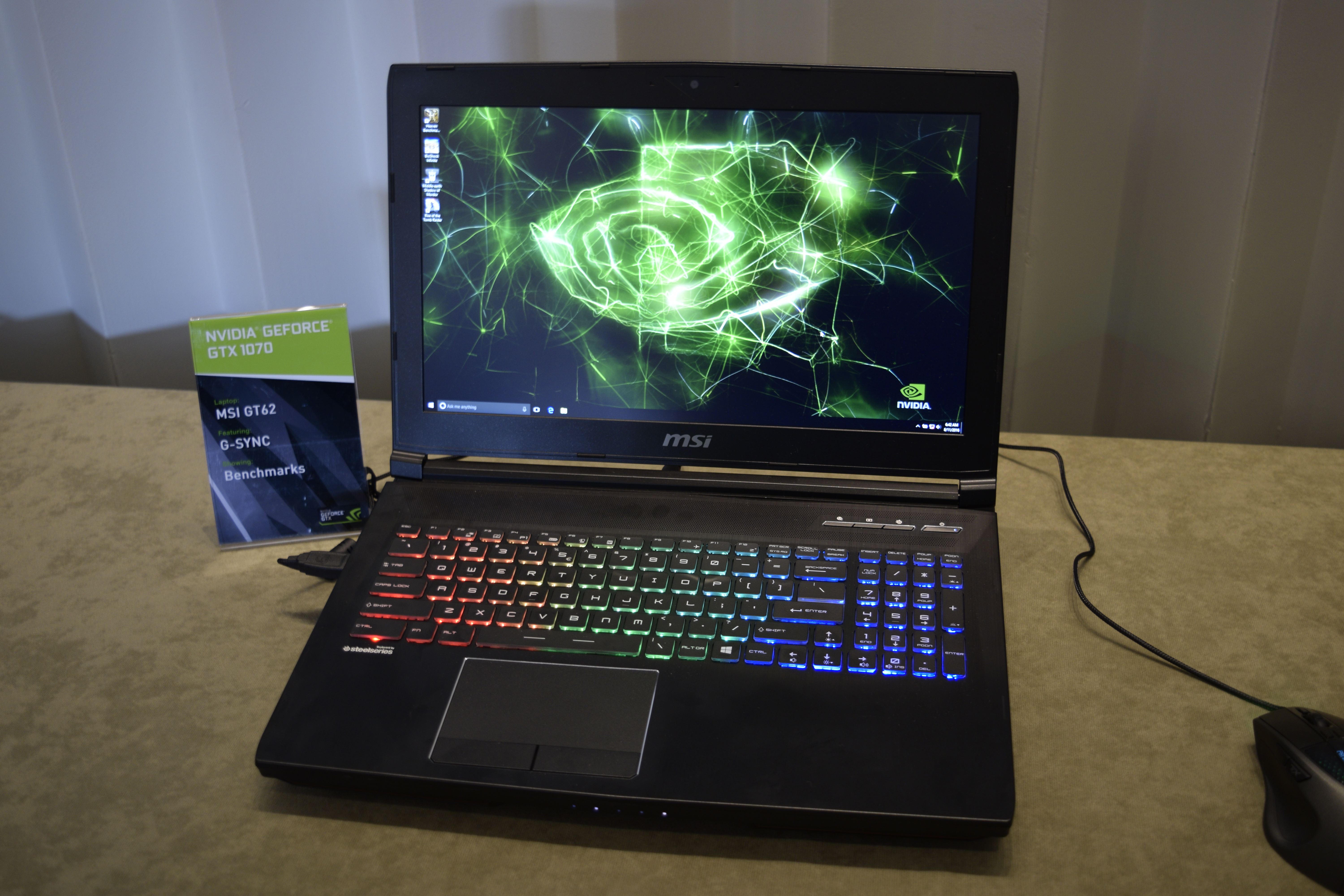Nvidia Launches Mobile Pascal: 1060, 1070 And 1080 Desktop-Class Graphics
Only a few weeks after announcing the Titan X, the company revealed its new Pascal-based mobile graphics solutions at a special event in the UK. Meet the mobile-focused GeForce GTX 1060, 1070, and 1080.
No M, No Problem
Previously, Nvidia’s 900-series modules bore the usual “M” designation, and their performance was not comparable to the desktop models with the same number scheme. That all changed with the GeForce GTX 980 MXM card, which dropped the “M” and offered just as much horsepower as its desktop counterpart. This time around, the company is selling three different desktop-class GPUs in mobile packages, sans the “M.”
The mobile GeForce GTX 1060, 1070, and 1080 are all VR-ready, and Nvidia says the GPUs yield similar performance as its desktop cards, up to 76 percent faster than the Maxwell-based predecessors. They are built using the same 16 nm FinFET process, and each mobile solution employs the same GPU (GP104/GP106) as its desktop counterpart.
Nvidia was vague on the subject of TDP, saying power would differ between OEM implementations and that the company typically does not provide a TDP for its mobile GPUs. Undoubtedly, the power consumption of each module will be lower than the desktop versions in order to work within the constraints of a notebook form factor. In fact, the company revealed that the GTX 1060, 1070, and 1080 would fall into the same power envelope as the GTX 970M, 980M, and 980, respectively.
Although the base clock rates of these solutions take a dive compared to the desktop implementations, overclocking potential should be similar. For example, we witnessed a successful 225 MHz base clock boost to a 1080-equipped laptop running Doom. Furthermore, OEMs can tune the GPUs any way they want, and factory-overclocked variants are sure to make their way to market, with some likely to meet or exceed the reference desktop clock rates.
Better GPUs Means Better Display Technology
According to Nvidia, thanks to the huge performance leap enabled by its Pascal-based GPUs, laptops equipped with 10-series modules (specifically the GTX 1080) deliver playable performance on 4K displays using high-quality settings. They also give notebooks with 1080p panels the ability to drive a 120 Hz refresh rate for the first time. This was always possible with an external display using DisplayPort, but now it's all on-board. In addition, 1440p displays with the aforementioned 120 Hz refresh rate are making their first appearance on gaming laptops, all thanks to the new Pascal-based GPUs. G-Sync is also supported by many of these gaming displays.
GTX 1080
The mobile GeForce GTX 1080 is the direct successor to the first desktop-class GTX 980, and it’s nearly identical to the desktop version of the 1080. It utilizes the same GP104 GPU with 20 SMs for a total of 2560 CUDA cores and 160 texture units. The mobile version also gets the same GPU Boost rating as the desktop version (1733 MHz), though the base clock frequency is down to 1556 MHz. The 8 GB of 10 Gb/s GDDR5X and 256-bit memory bus are also along for the ride. Of course, this level of performance has never been seen in a laptop (without the use of a GPU dock) until now.
Get Tom's Hardware's best news and in-depth reviews, straight to your inbox.
Expect to find Nvidia's GTX 1080 in the flagships of several premium mobile platforms, with SLI support and robust coolers to accommodate the powerful GPU. In other words, expect to pay dearly for a notebook with one of the 4K-capable engines inside.
At the launch event, we were able to run Unigine Heaven on an upcoming Clevo laptop. Although the system mistakenly identified its GPU as a 4 GB variant of the 1080, we measured nearly the same level of performance as the desktop version. It dominates the previous generation's best mobile effort (in this case, the AVADirect Avant P870DM-G with a GTX 980 inside).
Compared to 10-series desktop GPUs, the mobile GTX 1080 falls just below the performance of Nvidia's Founders Edition card, and it beats the discrete GeForce GTX 1070. Up until a few weeks ago (thanks, Titan X), the GTX 1080 was the world’s fastest consumer graphics card, and the mobile version comes close to matching it, cruising right on by the GTX 980 without any help from overclocking.
GTX 1070
Nvidia made some changes to the mobile version of GeForce GTX 1070 compared to its desktop configuration, most notably the CUDA core count and clock rates. As a direct replacement for the GTX 980M (with a similar TDP), the base and boost frequencies fell to 1442 MHz and 1645 MHz, respectively (versus the reference design’s 1506 MHz base clock and 1683 MHz boost rating). This was done to reduce power consumption, presumably.
Curiously, Nvidia enabled an extra SM (yielding 16, compared to the Founders Edition's 15) to give the mobile 1070 a total of 2048 CUDA cores (versus 1920). Of course, this also means an additional eight texture units, for a total of 128.
The company justifies these additional resources as a means of compensating for the lower clock rates, and as a result, performance should be similar to the desktop version. However, it's possible that overclocking certain implementations of the mobile GTX 1070 (laptops with proper cooling and power) will facilitate comparable or better performance compared to the desktop 1070 because of the extra CUDA cores and texture units. Not surprisingly, their back-ends are identical, with 8 GB of 8 Gb/s GDDR5 sitting on a 256-bit memory bus.
GTX 1060
The mobile GTX 1060 directly replaces the GTX 970M (at least as far as power goes), and it sports the same GP106 GPU as the desktop 1060. Again, you get more conservative frequencies from the graphics processor, which are down to 1404 MHz and 1670 MHz, respectively (the Founders Edition card features a 1506 MHz base clock and 1708 MHz GPU Boost rating). It features the same 10 SMs (enabling 1280 CUDA cores), 80 texture units, and identical memory specifications (up to 6 GB of 8 Gb/s GDDR5 on a 192-bit memory bus).
For those surprised that the GTX 1060 doesn't also enjoy the benefit of a higher core count, there’s a good explanation. GP106, as it appears in the GTX 1060, is already a fully-enabled GPU, and it can’t be altered to gain another SM, as the mobile 1070 can (and was). However, it should perform in the same ballpark as the desktop version, and overclocking can make it even better. Also similar to the desktop cards, SLI is not an option for the mobile version of GTX 1060.
Compared To Maxwell, There Is No Comparison
When Nvidia first launched the mobile GTX 980, it was met with some skepticism. Never before had laptops been able to support VR HMDs, nor were they able to contend with top desktop graphics cards. The fact it scored in the same performance ballpark as the full-sized version was a shock to many, but the first GPU to drop the “M” suffix was a huge leap in mobile graphics processing. Naturally, it wasn't cheap, and enthusiasts had to pay to play if they wanted to have a VR-ready laptop with a GTX 980.
This time around, three desktop-class GPUs are being fashioned for use in notebooks, and all three are VR-ready. These graphics modules offer more performance for the dollar than any previous-generation GPU Nvidia has released, and the GTX 980 is no longer the only option in town for a true VR and 4K gaming laptop.
The company declared that the GTX 1060, 1070, and 1080 mobile GPUs are the direct successors to the 970M, 980M and 980 (respectively), but this is only in the matter of price point and TDP (although a set number for either wasn’t provided). The only GPU from the previous generation that was comparable in performance was the GTX 980, which is now only barely ahead of the GTX 1060 in the graphics card hierarchy. Moreover, GTX 1060-equipped laptops were said to be priced starting around $1399, which makes these new VR-ready notebooks considerably more affordable compared to previous laptops sporting the dethroned GTX 980.
Availability
The new GeForce 10-Series mobile GPUs are available now, but if this is anything like the desktop card release, quantities may not last. At the UK launch event, we saw a variety of systems equipped with GTX 1060, 1070 and 1080 GPUs from top vendors including MSI, HP, Clevo, Asus, Acer, and Razer, so stay tuned for the imminent tidal wave of updated and newly-designed gaming laptops from your favorite brands.
| Laptop GPU | GTX 1080 | GTX 1070 | GTX 1060 | GTX 980 |
|---|---|---|---|---|
| SMs | 20 | 16 | 10 | 16 |
| CUDA Cores | 2,560 | 2,048 | 1,280 | 2,048 |
| Base Clock | 1,556 MHz | 1,442 MHz | 1,404 MHz | 1,064 MHz |
| Boost Clock | 1,733 MHz | 1,645 MHz | 1,670 MHz | 1,126 MHz |
| GFLOPs (Base Clock) | 7967 | 5906 | 3594 | 4358 |
| Texture Units | 160 | 128 | 80 | 128 |
| Texel Fill Rate | 277.3 GT/s | 210.6 GT/s | 133.6 GT/s | 144.1 GT/s |
| Memory | 8 GB GDDR5X | 8 GB GDDR5 | Up to 6 GB GDDR5 | 8 GB GDDR5 |
| Memory Data Rate | 10 Gb/s | 8 Gb/s | 8 Gb/s | 7 Gb/s |
| Memory Bandwidth | 320 GB/s | 256 GB/s | 192 GB/s | 224 GB/s |
| Memory Bus | 256-Bit | 256-Bit | 192-Bit | 256-Bit |
Derek Forrest was a contributing freelance writer for Tom's Hardware. He covered hardware news and reviews, focusing on gaming desktops and laptops.
-
Xajel Okay, so 1060 is the successor to 970M with both having 75W TDP... when we will see 960M successor then ?Reply -
wifiburger 75w TDP hahaha, seriously nvidia, big fail pushing 75w out of form factor of notebooks,Reply
bulky notebooks are desktop replacement not proper notebooks, look at apple :-) -
Samer1970 Reply18445065 said:Okay, so 1060 is the successor to 970M with both having 75W TDP... when we will see 960M successor then ?
1050 coming as well ... be patient . -
Elrabin Reply18445578 said:75w TDP hahaha, seriously nvidia, big fail pushing 75w out of form factor of notebooks,
bulky notebooks are desktop replacement not proper notebooks, look at apple :-)
75w is the same TDP as the GTX 960m which was able to be slotted into Ultrabooks such as a XPS15.
Hell, the GTX 970m was in the Razer Blade.
These are 75% faster for the same TDP, how the hell is that a fail? -
Xajel Reply18445806 said:18445065 said:Okay, so 1060 is the successor to 970M with both having 75W TDP... when we will see 960M successor then ?
1050 coming as well ... be patient .
I know, but it will take some time as the desktop part isn't out yet... -
Xajel Reply18445578 said:75w TDP hahaha, seriously nvidia, big fail pushing 75w out of form factor of notebooks,
bulky notebooks are desktop replacement not proper notebooks, look at apple :-)
75W TDP was the TDP of 970M, which you can find in just few thin design, mentioning Razer blade 14" fox example, not as thin as other but a good example... -
Xajel Reply18446177 said:18445578 said:75w TDP hahaha, seriously nvidia, big fail pushing 75w out of form factor of notebooks,
bulky notebooks are desktop replacement not proper notebooks, look at apple :-)
75w is the same TDP as the GTX 960m which was able to be slotted into Ultrabooks such as a XPS15.
Hell, the GTX 970m was in the Razer Blade.
These are 75% faster for the same TDP, how the hell is that a fail?
960M was 60~65W TDP, only 970M was 75W...
and 970M did have a good performance jump over 960M, though it didn't have much design wins compared to 960M
and yes 970M was in Razer Blade 14", 960M was in thinner designs such as XPS 13 & 15...
-
Brian_R170 Couldn't an OEM put one of the mobile GPUs onto a PCIe graphics card and make a really fast card requires no auxiliary power, is < 7 inches long, only takes up 1 slot, and possibly even half-height?Reply






